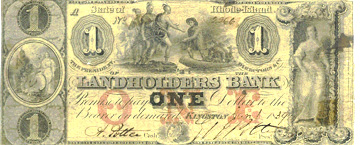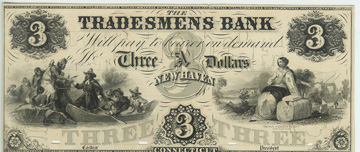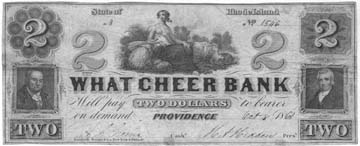WHAT CHEER, NETOP?
By C. J. F. Reprinted from Paper Money, vol. XVIII, Whole No. 84
Tracing the historical significance of vignettes or titles appearing on U.S. broken bank notes offers quite a challenge and invariably the chase terminates at some library, historical society or in the stacks of mildewed books and references so often found in some obscure antique shop.
The note of the What Cheer Bank pictured here long ago piqued my interest as to the origin of its title. This title, it seems, can be traced back to the days of the Puritans and Roger Williams, one of the true friends of the American Indians in the New England Colonies. He was humanitarian toward them and became a person they could put their trust in. He made many friends among them, including Canonicus, a chieftain of the Narragansetts. This increased his unpopularity with the Puritan magistrates to the point where they conspired to kidnap and return him to England. Luckily Williams heard of this plot and escaped to the wilderness with his servant Thomas Angell, but leaving his family behind.
After living in this form of exile for a few months, he settled on the east bank of the Seekonk River in Rehoboth, Massachusetts, where his Indian friends helped him clear land and start building a house. He planned to relocate his family here. Eventually five more of his friends joined him in the endeavour.
Good fortune was not in store, however, as the governor of Plymouth, (Winslow) advised Williams by letter that he was settling on land of his jurisdiction and was not welcome there.
Forsaking the half-built homes, the bank of six men put out in a canoe from the shore that marked the western boundary of the colony that rejected them. They paddled to the opposite shore, where suddenly outlined against the sky a group of native warriors loomed before the gaze of the startled strangers. The group feared the worst until the Indian spokesman shouted the greeting, which Rhode Islanders have come to regard as the friendliest of welcomes. “What Cheer, Netop?” (Netop, an Indian word meaning friend!)
This greeting from the native warriors seemed to be the turning point of the fortunes of Roger Williams. He had come to the land of his friend, Canonicus. He believed that only by God’s own providence was he led to this land and thereafter named this area Providence.
The directors of at least four state banks in New England saw fit to commemorate this event on the notes issued by their banks. One bank was actually titled the “What Cheer Bank”.

Another, the Landholders Bank of Kingston, Rhode Island, issued a one-dollar note depicting the “Landing of Roger Williams”.

A similar vignette appears on a three-dollar note of the Tradesmens Bank of New Haven, Connecticut.
It is interesting to note that the vignette used on the note of the Tradesmens Bank is identical to the seal of the City of Providence. This rendition was engraved by the American Banknote Company. The engraving on the Landholders Bank note is a copy, not exact, of an engraving by T.F. Hoppin that was published with The New Mirror, January 27, 1844. The original engraving on the banknote shows only four subjects in the canoe and fewer Indians. In both instances we can surmise that the banknote engraver was less interested in historical fact than in reduction of the subject matter in order to fit the confines of the banknotes.
|











